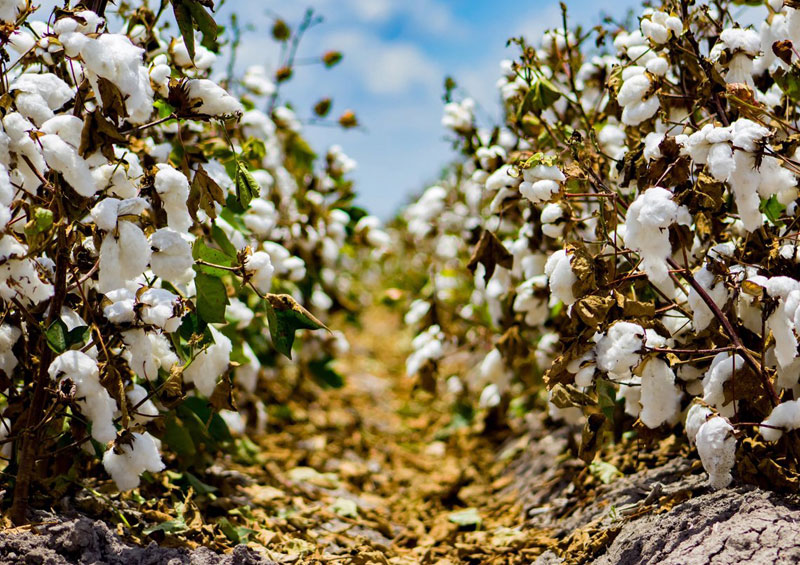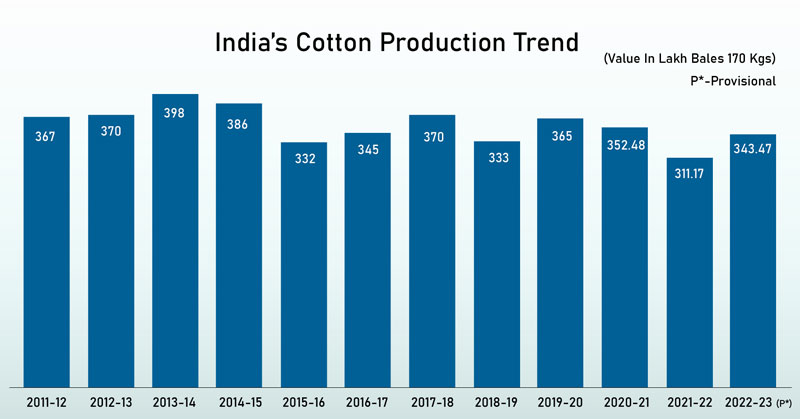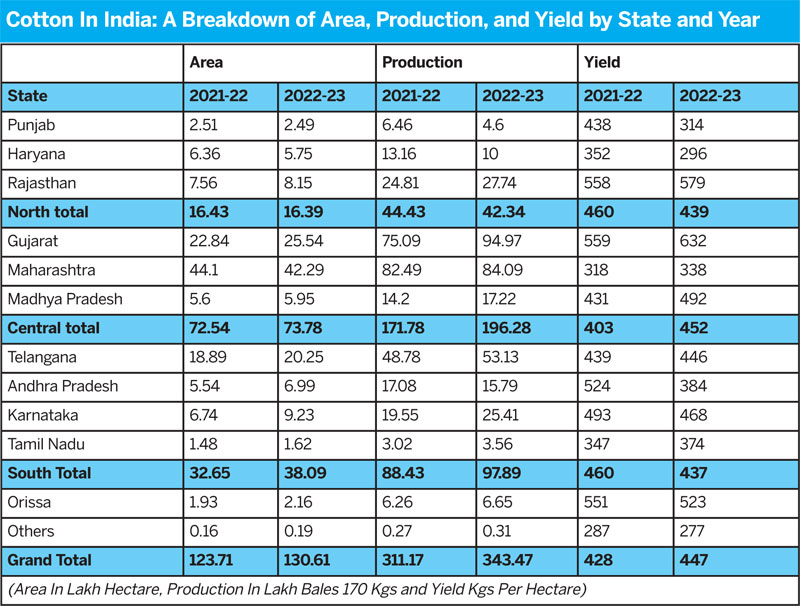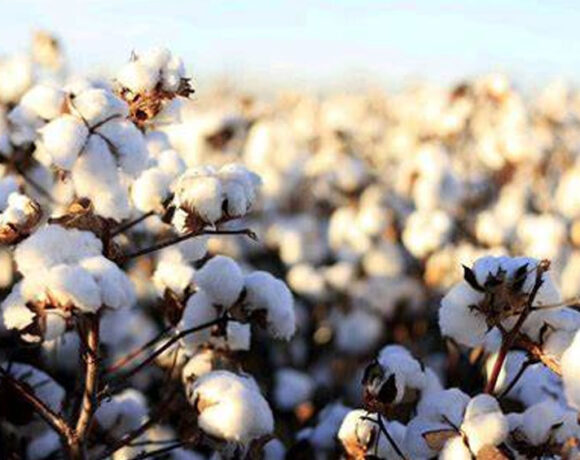India’s Cotton Production Recovers In 2022-23 Season

Cotton production in India is a significant component of the country’s agricultural landscape and economy. In the 2022-23 cotton season, India witnessed a notable recovery in cotton production, with an overall increase of 10.38% compared to the previous year. This improvement marks a significant shift from the 11.72% drop observed in the 2021-22 season.

Central Zone
The central zone emerged as the powerhouse of cotton production in India, accounting for a staggering 57% of the country’s total cotton output. In the 2022-23 season, the zone’s production surged by an impressive 14.26% to 196.28 lakh bales. This growth reflects the central zone’s ability to adapt and thrive. Gujarat, the leading cotton-producing state, saw an impressive 26.47% growth in cotton production, contributing 48% of the zone’s output. Maharashtra, the second-largest producer in the region, increased its production marginally, while Madhya Pradesh achieved a remarkable 9% growth. The region’s overall productivity improved, with yields increasing by 12.16%.
Northern Zone
The northern zone, though experiencing a minor decrease in cultivation area, showed positive signs of recovery. After a dramatic 30.05% decline in cotton production during the previous season, the zone registered a modest drop of 4.70% in 2022-23. Rajasthan, the leading cotton-producing state in this zone, displayed a remarkable growth of 11.81%, emphasizing the region’s potential. This increase reflects positively on the state’s agricultural practices, with yields rising by 3.76%. Conversely, Haryana’s cotton production plummeted by 24%, resulting in a 15.91% decrease in productivity. Punjab, the lowest producer in the zone, experienced a substantial drop of 28.79% in cotton production.
Southern Zone
The southern zone, the second-highest cotton-producing region in India, witnessed a significant growth of 10.70% in cotton production, totaling 97.89 lakh bales. Telangana emerged as the highest cotton-producing state in this zone, with an 8.92% increase in production. This reinforces the southern zone’s role in driving India’s cotton production. Karnataka led the growth-wise chart with a remarkable 29.97% increase in cotton production, accompanied by a substantial expansion in the area under cultivation. Andhra Pradesh, while witnessing a growth in cultivation area, saw a decline in cotton production, reflecting challenges faced by the state’s cotton industry. Tamil Nadu, the lowest producer in the zone, managed a growth of 17.88% in cotton production.

India’s Cotton Exports
India’s cotton textile exports experienced a notable decline of 23.01% during the first eight months of 2023, totaling US$ 4331.74 million when compared to the corresponding period of the last year. This decline indicates challenges faced by the cotton textile industry. The cotton fibre exports from India were down by a substantial 51.89% in the first eight months of 2023, amounting to US$ 616.14 million. This decline, accompanied by a 38.08% reduction in cotton fibre volume, points to complexities in this segment of the cotton market.
India’s cotton yarn exports also experienced a decrease of 10.07% during the same period, totaling US$ 2427.18 million. Notably, cotton yarn comprises 56% of the total cotton textile exports. However, in terms of volume, cotton yarn exports increased by 29.84% to 747.23 million kgs, revealing an intriguing paradox.
The exports of cotton fabric from India declined by 21.76% to US$ 1294.42 million during the first eight months of 2023. Interestingly, the volume of cotton fabric exports increased by 6.71% to 2202.30 million sq. metres, hinting at shifting preferences in international markets.
In this period, Bangladesh remained the top destination for Indian cotton textiles, despite a decline in exports of 51.35% to US$ 1247.62 million. On the other hand, exports to China witnessed a remarkable surge of 380.32%, amounting to US$ 639.10 million. This increase marks China’s shift from the fifth largest market to the second largest for Indian cotton textiles. India’s cotton exports to Turkey have seen a rise of 26.97%, totaling US$ 138.41 million during the first eight months of 2023. This increase signifies a growing demand for Indian cotton in the Turkish market.
Global Cotton Production Decline
The world’s cotton production landscape for the 2022-23 season presents a mix of challenges and successes. The global cotton production for the 2022-23 season experienced a marginal decline of 2.66%, amounting to 24.51 million metric tonnes of cotton. This dip reflects various factors affecting cotton production worldwide.
China retains its position as the world’s largest cotton-producing country for the 2022-23 season. The nation’s cotton production reached 5.98 million metric tonnes, signifying a commendable growth of 4.36%. China continues to demonstrate its commitment to cotton agriculture. India emerges as the second-largest global cotton producer in the 2022-23 season, sharing an equal 24% of the world’s total cotton production with China.
India’s cotton production soared to 5.84 million metric tonnes, registering an impressive growth rate of 10.40%. This surge underscores India’s significant potential in the cotton industry and its capacity to compete on the international stage.
In stark contrast, Pakistan’s cotton production plummeted by a substantial 33.07%. This decline underscores the formidable challenges confronting Pakistan’s cotton sector, including issues like pest infestations, farming practices and crop diseases. Addressing these challenges is critical for the revival of Pakistan’s cotton industry.
Brazil stands out as a success story in the 2022-23 season, with a remarkable 18.43% increase in cotton production. Brazil’s success highlights the country’s dedication to cotton agriculture and its effective utilization of advanced farming techniques.
(Article by Henry Dsouza, Associate Editor of Textile Insights)















